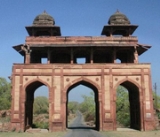
Naqqar khana
Encyclopedia

Mughal architecture
Mughal architecture, an amalgam of Islamic, Persian, Turkish and Indian architecture, is the distinctive style developed by the Mughals in the 16th, 17th and 18th centuries in what is now India, Pakistan, Bangladesh and Afghanistan. It is symmetrical and decorative in style.The Mughal dynasty was...
. They are found in India
India
India , officially the Republic of India , is a country in South Asia. It is the seventh-largest country by geographical area, the second-most populous country with over 1.2 billion people, and the most populous democracy in the world...
, Pakistan
Pakistan
Pakistan , officially the Islamic Republic of Pakistan is a sovereign state in South Asia. It has a coastline along the Arabian Sea and the Gulf of Oman in the south and is bordered by Afghanistan and Iran in the west, India in the east and China in the far northeast. In the north, Tajikistan...
, and other nearby countries. The name comes from Naqqar or Naubat meaning Shehnai
Shehnai
The shehnai, shahnai, shenai or mangal vadya, is an aerophonic instrument, a double reed conical oboe, common in North India, West India and Pakistan, made out of wood, with a metal flare bell at the end...
and khana means 'a place related to', thus Naubat khana means a place where Shehnai is performed.

Delhi
Delhi , officially National Capital Territory of Delhi , is the largest metropolis by area and the second-largest by population in India, next to Mumbai. It is the eighth largest metropolis in the world by population with 16,753,265 inhabitants in the Territory at the 2011 Census...
, on the eastern side of the ten pillars lane, was the main entrance and a pavilion where royal palanquins and other paraphernalia were placed. There was another pavilion housing 18 kinds of musical instruments that used to form part of the royal entourage. This pavilion was named Naubatkhana and was dilapidated until 100 years ago. The Naubatkhana was in such disrepair during the last century that the American Mission declined to take it as a gift, and then it was restored by George Fisher in 1858 for the new Zilla School. Naubatkhana also was used for some time as the police headquarters. Now the building serves as a middle school facility for the Sourastra Community.
The construction of the palace was completed in 1636. During 1659 it suffered damage by the ruler of the time, the grandson of the carpenter Thirumalai Naick. His grandson Chockanatha Naick, in order to carry the materials to Trichy to establish a new palace, pulled down some of the portions like Rangavilasam. The throne, costly jewels, and other valuable treasures were taken to Trichy. The materials were not utilized at Trichy, and no palace was constructed. Much of the rest of the palace disappeared. In the last century, a part of the building to the west of the celestial pavilion collapsed under a heavy rainstorm. People encroached upon much of the palace, and they converted it into their homes.
Bharat Ratna
Bharat Ratna
Bharat Ratna is the Republic of India's highest civilian award, awarded for the highest degrees of national service. This service includes artistic, literary, and scientific achievements, as well as "recognition of public service of the highest order." Unlike knights, holders of the Bharat Ratna...
Bismillah Khan
Bismillah Khan
Ustad Bismillah Khan was an Indian shehnai maestro. He was the third classical musician to be awarded the Bharat Ratna , the highest civilian honour in India and gained worldwide acclaim for playing the shehnai for more than eight decades....
's family had played shehnai for generations in Naubatkhana, which overlooked palaces and temples, and enabled their music to be heard across the countryside.

